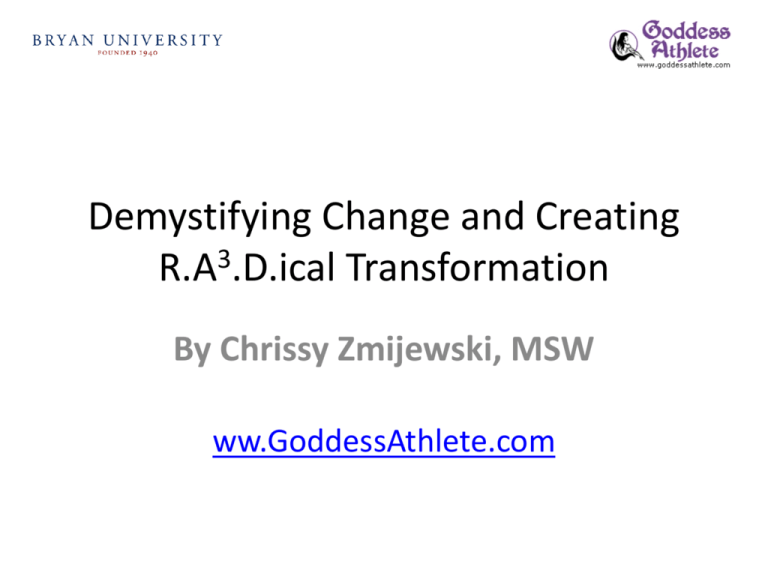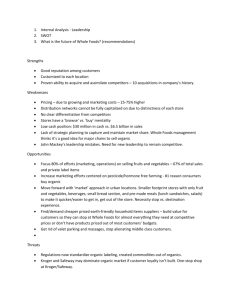Demystifying Change and Creating R.A.D.ical Transformation
advertisement

Demystifying Change and Creating R.A3.D.ical Transformation By Chrissy Zmijewski, MSW ww.GoddessAthlete.com About Chrissy • • • • • • • • • • Master of Social Work & B.A. in Psychology, Washington University in St. Louis; concentration on mental health and eating disorders Conducted research and published my study linking eating disorders and exercise addiction Subject Matter Expert (SME) and curriculum designer for Bryan University Associates in Advanced Personal Training and Exercise Science and Bachelors in Professional Fitness Training and Exercise Science NASM CPT and PES; ISSA SFN; Power Plate Level 1; Yoga Alliance RYT-500 Hour Author of “The R.A2.D. Triad” and contributing editor for several magazines Led training seminars for personal trainers & group exercise instructors at Canyon Ranch, 24 Hour Fitness, California Family Fitness, & Wellbridge Spa Keynote speaker and presenter at the 2010 and 2011 Pro Series Natural Bodybuilding Training Camp International fitness, nutrition, and lifestyle coach for the last 16 years IFPA and WNBF Professional Figure Competitor and Bodybuilder since 2008 2012 IFPA Figure World Champion Objectives: • Understand the mind-body connection • Understand the role of subconscious programming & learn ways to change that programming • Identify R.A3.D. techniques that affect the mind-body connection • Prioritize client needs & implementation of these techniques Change vs. Transformation Change • Outside-in approach • Requires constant monitoring • Requires controlling thoughts, feelings, & behaviors Transformation • Inside-out approach • No monitoring required • Thoughts, feelings, & behaviors never occur Two Foundational Principles for Transformation Mind influences the body Body influences the mind The Mind Influences the Body • Sexual Arousal • Placebo/Nocebo Effect • Thinking about someone you love vs. someone you hate The Body Influences the Mind • “Runner’s high” • Gut-Brain-Body Connection - Diet & dementia - Gut health affects mind and body - Microbes affect cravings and mood Gut-Brain-Body Connection • If the gut is happy, the brain will be happy and more easily go into a parasympathetic state • GI stress can exacerbate anxiety & depression through neural feedback • Bad bacteria, yeast, mold, & parasites cause a release of inflammatory cytokines • Dysbiosis can lead to IBS, chronic fatigue, obesity, acne, cancer, and autoimmune conditions Gut Bacteria & Unhealthy Eating Credit: University of California, San Francisco (UCSF). Retrieved from www.sciencedaily.com/releases/2014/08/140815192240.htm Causes of Dysbiosis • Antibiotics and drugs (illicit and OTC) • Alcohol • Toxins • Diet (food allergens, sugar, grains) • Stress (psychological and physical) Two Foundational Principles for Transformation Mind influences the body Body influences the mind Reduce Inflammation Get into the PNS Break it down Repetition Focus on what you WANT Reassurance Transformation Celebrate success Feedback Loop Behaviors Thoughts Feelings Subconscious vs. Conscious Mind Subconscious Mind • 95+% of the time your brain is operating from here • Automatic programming • Takes over when in the Sympathetic Nervous System • React- survival • Processes 20,000,000 environmental stimuli/sec • Need to reprogram or the past will become the future Conscious Mind • <5% of the time your brain is operating from here • Can only function well when in the Parasympathetic Nervous System • Respond, reflect, choose • Processes 40 environmental stimuli/sec fMRI Can Predict Your Behavior Keim, B. (2008, April). Brain Scanners Can See Your Decisions Before You Make Them. Retrieved from http://archive.wired.com/science/discoveries/news/2008/04/mind_decision. The Role of Neuroplasticity • The brain’s ability to reorganize itself throughout life due to changes in behavior, environment and neural processes. • This concept changes the belief that, “once X, always X.” Keep in mind… Conscious learning ≠ change Your Subconscious Programming • Look at your body and your life • Why you have it/how you got it/what it is doesn’t matter • Determine what you DO WANT for the future • Follow the path of least resistance; don’t force a change on an old program How do you transform? Trauma Energy Psychology Hypnosis REPETITION Transformation Through R.A.3D. Repetition Reduce Inflammation Get into the PNS Break it down Repetition Focus on what you WANT Reassurance Transformation Celebrate success Rest & Relaxation • Mini-breaks - Awareness/meditation techniques - Massage - Power naps - Hobby (gardening, singing, playing an instrument) - Taking a bath - Playing with a pet - Being in nature • Improving the Quality of Sleep - Food/liquid - Effects of blue light - Bedroom set-up - Evening ritual Activity • Make your sessions fun & encourage laughter • Get outside • Work in groups: pain/fatigue resistance, motivation, touch • Use music Attitude • The mind doesn’t know the difference between imagination and reality. • Use the mind to your advantage: - Affirmations - Vision board - Success/gratitude journal - Laughter - Daily intentions, visualization Awareness • Breath focus • Meditation (seated or walking) • Skill development • Mindful movement Diet: Two Considerations • HOW you eat - Cephalic phase digestive response (CPDR) - Dichotomous listening - Digestive response while watching TV - Role of pleasure/enjoyment • WHAT you eat – Nourish the beneficial microbes – Prebiotics, probiotics, dietary choices FRESH IS BEST!! Nutrition Continuum Sensory Overload & Nutritional Deprivation Sensory & Nutritional Balance FRUITS AND VEGETABLES Commercially grown Commercially grown & local Certified Organic Certified Organic & local Canned or fried fruit, fruit with added sugar; bottled fruit juice Dried fruit with additives Dried or frozen fruit without additives; fruit smoothies with all fresh ingredients; freshly made fruit juice (diluted with water) Fresh fruit Vegetables cooked via frying, microwaving or sautéing Dried vegetables with additives Lightly steamed or cooked vegetables; freshly juiced vegetables; vegetable stews, dried or frozen vegetables without additives Fresh vegetables Nutrition Continuum Sensory Overload & Nutritional Deprivation Sensory & Nutritional Balance PROTEIN Commercial beef, Commercial beef, chicken, turkey, and chicken, turkey, and eggs raised with eggs raised without hormones or antibiotics hormones or antibiotics Farm-raised fish Fresh meats grilled, fried, or cooked at high temperatures; deli meats; processed meat products (Spam, hot dogs, salami, sausage) Organic beef, chicken, turkey, and eggs Free-range, organic beef, chicken, turkey, and eggs Wild fish Frozen meats seared or boiled at low temperatures Fresh meats seared or boiled at low temperatures Nutrition Continuum Sensory Overload & Nutritional Deprivation Sensory & Nutritional Balance OILS/NUTS Roasted, salted, or Pasteurized commercial Pasteurized raw organic sweetened nuts (with nuts; organic or nuts; raw organic nut or without added oil); commercial nut butters butters with no added nut butters with salt, without hydrogenated ingredients (sold in the hydrogenated oils, or oils, sugars or salt (sold refrigerated section) sugars on the shelves) Commercial oils in Cold-pressed Raw, cold-pressed clear, plastic containers commercial oils in clear organic oils in clear glass bottles glass bottles Raw organic nuts Raw, cold-pressed organic oils in dark glass bottles Nutrition Continuum Sensory Overload & Nutritional Deprivation Sensory & Nutritional Balance GRAINS AND BEANS All other grain and bean Whole grains (oats, products (bread, cereal, brown rice, wild rice); crackers, cakes, chips, Sprouted Ezekial bread; pasta, rice, canned and slow-cooked dry beans; refried beans, etc.) sprouted grains or beans DAIRY All dairy products Dirty Dozen Plus • • • • • • • • Apples Strawberries Grapes Celery Peaches Spinach Sweet bell pepper Nectarines- imported • • • • Cucumbers Cherry tomatoes Snap peas- imported Potatoes • Hot peppers • Kale/collard greens Clean Fifteen • • • • • • • • Avocados Sweet corn Pineapples Cabbage Sweet peas- frozen Onions Asparagus Mangoes • • • • • • • Papayas Kiwi Eggplant Grapefruit Cantaloupe Cauliflower Sweet potatoes Sustainable Meat • Free-range • Certified Organic • Local Is your water clean? • Chlorine • Fluoride • Other contaminants • Avoid tap water Anti-Inflammatory Nutrients • Coconut oil (w/o hexane) • Omega 3s • Probiotics Inflammation Prevents Transformation Gluten Refined sugar and sugar substitutes Trans fats Caffeine Dairy Putting it All Together • Test it on yourself • Design a comprehensive intake form - Habits - Rest - Activity - Attitude/Awareness - Diet - Stressors • Find out more through dialogue - Self-talk (positive and negative) - Motivators (intrinsic and extrinsic) - Goals/dreams Putting it All Together • Choose 1 or 2 things to work on, based on: - Greatest impact - Client willingness - Client excitement • Keep the psychology to yourself. Key Points • • • • • • Mind influences the body and vice versa. Transformation must include both of these. Get into the PNS as much as possible. Decrease inflammation, especially in the gut. Determine what you WANT. Use R.A.3D. Techniques to support the transformational process. • Repeat, repeat, repeat. Thank you Nor-Cal Fitness Summit Questions???? References • David, M. (2005). The Slow Down Diet: Eating for Energy, Pleasure, and Weight Loss. Rochester, VT: Healing Arts Press. • Deans, E. (2014, April 6). The Gut-Brain Connection, Mental Illness, and Disease: Psychobiotics, immunology, and the theory of all chronic disease. Evolutionary Psychiatry. • Dispenza, J. (2007). Evolve Your Brain: The Science of Changing Your Mind. Deerfield Beach, FL: Health Communications, Inc. • Doidge, N. (2007). The Brain That Changes Itself: Stories of Personal Triumph from the Frontiers of Brain Science. New York, NY: Penguin Books. • EWG's 2014 Shopper's Guide to Pesticides in Produce™. (2014, April). Retrieved from http://www.ewg.org/foodnews/ • Hamilton, D. (2010). How Your Mind Can Heal Your Body. Carlsbad, CA: Hay House Inc. References • Keim, B. (2008, April). Brain Scanners Can See Your Decisions Before You Make Them. Retrieved from http://archive.wired.com/science/discoveries/news/2008/04/mind _decision. • Lipton, B. (2005). The Biology of Belief: Unleashing the Power of Consciousness, Matter, and Molecules. Carlsbad, CA: Hay House Inc. • Maier, S.F. & Watkins, L.R. (August 2012). Consequences of the Inflamed Brain. Dana Alliance. • Olson, J. (2005). The Slight Edge: Secret to a $uccessful Life. Lake Dallas, TX: Monumentum Media. • Perlmutter, D. (2013). Grain Brain: The Surprising Truth about Wheat, Carbs, and Sugar--Your Brain's Silent Killers. Park Avenue, NY: Hachette Book Group, Inc. References • Rankin, L. (2013). Mind Over Medicine: Scientific Proof that You Can Heal Yourself. Carlsbad, CA: Hay House Inc. • Siegel, D. (2010). Mindsight: The New Science of Personal Transformation. New York, NY: Random House, Inc. • University of California, San Francisco (UCSF). (2014, August 15). Do gut bacteria rule our minds? In an ecosystem within us, microbes evolved to sway food choices. ScienceDaily. Retrieved from www.sciencedaily.com/releases/2014/08/140815192240.ht m • Zmijewski, C. (2010). The R.A2.D. Triad: Transform Your Mind and Body. Northglenn, CO: Lulu, Inc. & Goddess Athlete.






